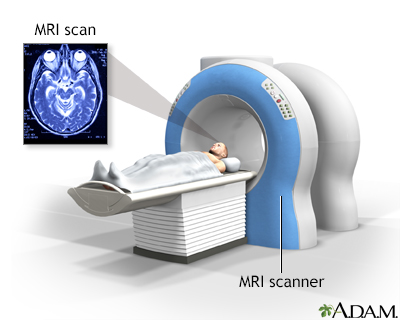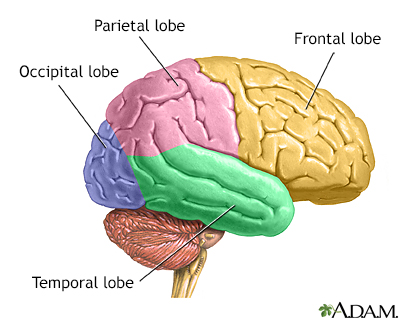Head MRI
A head MRI (magnetic resonance imaging) is an imaging test that uses powerful magnets and radio waves to create pictures of the brain and surrounding tissues.
It does not use radiation.
How the Test is Performed
A head MRI is done in the hospital or a radiology center.
You lie on a narrow table, which slides into a large tunnel-shaped scanner.
Some MRI exams require a special dye, called contrast material. The dye is usually given during the test through a vein (IV) in your hand or forearm. The dye helps the radiologist see certain areas more clearly.
IV
Intravenous means "within a vein. " Most often it refers to giving medicines or fluids through a needle or tube inserted into a vein. This allows th...
Read Article Now Book Mark ArticleDuring the MRI, the person who operates the machine watches you from another room. The test most often lasts 30 to 60 minutes, but may take longer.
How to Prepare for the Test
You may be asked not to eat or drink anything for 4 to 6 hours before the scan.
Tell your health care provider if you are afraid of close spaces (have claustrophobia). You may receive medicine to help you feel sleepy and less anxious. Or your provider may suggest an open MRI, in which the machine is not as close to the body.
You may be asked to wear a hospital gown or clothing without metal ties (such as sweatpants and a t-shirt). Certain types of metal can cause blurry images.
Before the test, tell your provider if you have:
- Brain aneurysm clips
- An artificial heart valve
- Heart defibrillator or pacemaker
- Inner ear (cochlear) implants
- Kidney disease or are on dialysis (you may not be able to receive contrast)
Kidney disease
Chronic kidney disease is the slow loss of kidney function over time. The main job of the kidneys is to remove wastes and excess water from the body...
 ImageRead Article Now Book Mark Article
ImageRead Article Now Book Mark Article - Recently placed artificial joint
- A blood vessel stent
Stent
A stent is a tiny tube placed into a hollow structure in your body. This structure can be an artery, a vein, or another structure, such as the tube ...
 ImageRead Article Now Book Mark Article
ImageRead Article Now Book Mark Article - Worked with sheet metal in the past (you may need tests to check for metal pieces in your eyes)
The MRI contains strong magnets. Metal objects are not allowed into the room with the MRI scanner. This includes:
- Pens, pocketknives, and eyeglasses
- Items such as jewelry, watches, credit cards, and hearing aids
- Pins, hairpins, metal zippers, and similar metallic items
- Removable dental work
How the Test will Feel
If you need dye, you will feel the needle pinch in your arm when the dye is injected into the vein.
An MRI exam causes no pain. If you have difficulty lying still or are very nervous, you may be given a medicine to relax. Too much movement can blur the images and cause errors.
The table may be hard or cold, but you can ask for a blanket or pillow. The machine makes loud thumping and humming noises when turned on. You can ask for ear plugs to help reduce the noise.
An intercom in the room allows you to speak to someone at any time. Some MRIs have televisions and special headphones that can help you pass the time or block the scanner noise.
There is no recovery time, unless you were given a medicine to relax. After an MRI scan, you can go back to your normal diet, activity, and medicines.
Why the Test is Performed
An MRI provides detailed pictures of the brain and nerve tissues.
A brain MRI can be used to diagnose and monitor many diseases and disorders that affect the brain, including:
- Birth defect
- Bleeding (subarachnoid, subdural or epidural bleed, or bleeding in the brain tissue itself)
Subarachnoid
Subarachnoid hemorrhage is bleeding in the area between the brain and the thin tissues that cover the brain. This area is called the subarachnoid sp...
Read Article Now Book Mark ArticleSubdural
A subdural hematoma is a collection of blood between the covering of the brain (dura) and the surface of the brain.
 ImageRead Article Now Book Mark Article
ImageRead Article Now Book Mark ArticleEpidural bleed
An epidural hematoma (EDH) is bleeding between the inside of the skull and the outer covering of the brain (called the dura mater).
 ImageRead Article Now Book Mark Article
ImageRead Article Now Book Mark Article - Aneurysms
Aneurysms
An aneurysm is a weak area in the wall of a blood vessel that causes the blood vessel to bulge or balloon out. When an aneurysm occurs in a blood ve...
 ImageRead Article Now Book Mark Article
ImageRead Article Now Book Mark Article - Infection, such as brain abscess
Brain abscess
A brain abscess is a collection of pus, immune cells, and other material in the brain, caused by a bacterial or fungal infection.
 ImageRead Article Now Book Mark Article
ImageRead Article Now Book Mark Article - Tumors (cancerous and noncancerous)
- Hormonal disorders (such as acromegaly, galactorrhea, and Cushing syndrome)
Acromegaly
Acromegaly is a condition in which there is too much growth hormone (GH) in your body.
 ImageRead Article Now Book Mark Article
ImageRead Article Now Book Mark ArticleGalactorrhea
Nipple discharge is any fluid that comes out of the nipple area in your breast.
 ImageRead Article Now Book Mark Article
ImageRead Article Now Book Mark ArticleCushing syndrome
Cushing syndrome is a disorder that occurs when your body has a high level of the hormone cortisol.
 ImageRead Article Now Book Mark Article
ImageRead Article Now Book Mark Article - Multiple sclerosis
Multiple sclerosis
Multiple sclerosis (MS) is an autoimmune disease that affects the brain and spinal cord (central nervous system).
 ImageRead Article Now Book Mark Article
ImageRead Article Now Book Mark Article - Stroke
Stroke
A stroke occurs when blood flow to a part of the brain stops. A stroke is sometimes called a "brain attack. " If blood flow is cut off for longer th...
 ImageRead Article Now Book Mark Article
ImageRead Article Now Book Mark Article
An MRI scan of the head can also determine the cause of:
- Muscle weakness or numbness and tingling
- Changes in thinking or behavior
- Hearing loss
- Headaches when certain other symptoms or signs are present
- Speaking difficulties
- Vision problems
- Dementia
Dementia
Dementia is a loss of brain function that occurs with certain diseases. It affects one or more brain functions such as memory, thinking, language, j...
 ImageRead Article Now Book Mark Article
ImageRead Article Now Book Mark Article
A special type of MRI called magnetic resonance angiography (MRA) may be done to look at blood vessels in the brain.
Magnetic resonance angiography
Magnetic resonance angiography (MRA) is an MRI exam of the blood vessels. Unlike traditional angiography that involves placing a tube (catheter) int...

What Abnormal Results Mean
Abnormal results may be due to:
- Abnormal blood vessels in the brain (arteriovenous malformations of the head)
Arteriovenous malformations of the head
A cerebral arteriovenous malformation (AVM) is an abnormal connection between the arteries and veins in the brain that usually forms before birth....
 ImageRead Article Now Book Mark Article
ImageRead Article Now Book Mark Article - Tumor of the nerve that connects the ear to the brain (acoustic neuroma)
Acoustic neuroma
An acoustic neuroma is a slow-growing tumor of the nerve that connects the ear to the brain. This nerve is called the vestibular cochlear nerve. It...
 ImageRead Article Now Book Mark Article
ImageRead Article Now Book Mark Article - Bleeding in or around the brain
- Brain infection
- Brain tissue swelling
- Brain tumors
Brain tumors
A metastatic brain tumor is cancer that started in another part of the body and has spread to the brain.
 ImageRead Article Now Book Mark Article
ImageRead Article Now Book Mark Article - Damage to the brain from an injury
- Fluid collecting around the brain (hydrocephalus)
Hydrocephalus
Hydrocephalus is a buildup of fluid inside the skull that leads to the brain pushing against the skull. Hydrocephalus means "water on the brain. "...
 ImageRead Article Now Book Mark Article
ImageRead Article Now Book Mark Article - Infection of the skull bones (osteomyelitis)
Osteomyelitis
Osteomyelitis is a bone infection. It is caused by bacteria or other germs.
 ImageRead Article Now Book Mark Article
ImageRead Article Now Book Mark Article - Loss of brain tissue
- Multiple sclerosis
Multiple sclerosis
Multiple sclerosis (MS) is an autoimmune disease that affects the brain and spinal cord (central nervous system).
 ImageRead Article Now Book Mark Article
ImageRead Article Now Book Mark Article - Stroke or transient ischemic attack (TIA)
Transient ischemic attack
A transient ischemic attack (TIA) occurs when blood flow to a part of the brain stops for a brief time. A person will have stroke-like symptoms for ...
 ImageRead Article Now Book Mark Article
ImageRead Article Now Book Mark Article - Structural problems in the brain
Risks
MRI uses no radiation. To date, no side effects from the magnetic fields and radio waves have been reported.
The most common type of contrast (dye) used is gadolinium. It is very safe. Allergic reactions to this substance rarely occur. However, gadolinium can be harmful to people with kidney problems who are on dialysis. If you have kidney problems, tell your provider before the test.
The strong magnetic fields created during an MRI can make heart pacemakers and other implants not work as well. It can also cause a piece of metal inside your body to move or shift.
Considerations
MRI is safe during pregnancy. In many cases MRI may be more sensitive than CT scan to problems in the brain such as small masses. CT is usually better at looking for small areas of bleeding.
Tests that may be done instead of an MRI of the head include:
- Head CT scan
Head CT scan
A head computed tomography (CT) scan uses many x-rays to create pictures of the head, including the skull, brain, eye sockets, and sinuses.
 ImageRead Article Now Book Mark Article
ImageRead Article Now Book Mark Article - Positron emission tomography (PET) scan of the brain
Positron emission tomography
A brain positron emission tomography (PET) scan is an imaging test of the brain. It uses a radioactive substance called a tracer to look for disease...
Read Article Now Book Mark Article
A CT scan may be preferred in the following cases, since it is faster and usually available right in the emergency room:
- Acute trauma of the head and face
- Bleeding in the brain (within the first 24 to 48 hours)
- Early symptoms of stroke
- Skull bone disorders and disorders involving the bones of the ear
Reviewed By
Jason Levy, MD, FSIR, Northside Radiology Associates, Atlanta, GA. Also reviewed by David C. Dugdale, MD, Medical Director, Brenda Conaway, Editorial Director, and the A.D.A.M. Editorial team.
Barras CD, Bhattacharya JJ. Current status of imaging of the brain and anatomical features. In: Adam A, Dixon AK, Gillard JH, Schaefer-Prokop CM, eds. Grainger & Allison's Diagnostic Radiology. 7th ed. Philadelphia, PA: Elsevier; 2021:chap 53.
Kalnins AU, Prost RW, Kim TA. Computed tomography and magnetic resonance imaging of the brain. In: Winn HR, eds. Youmans and Winn Neurological Surgery. 8th ed. Philadelphia, PA: Elsevier; 2023:chap 10.
Khan M, Schulte J, Zinreich SJ, Aygun N. Overview of diagnostic imaging of the head and neck. In: Flint PW, Francis HW, Haughey BH, et al, eds. Cummings Otolaryngology: Head and Neck Surgery. 7th ed. Philadelphia, PA: Elsevier; 2021:chap 8.



 All rights reserved.
All rights reserved.